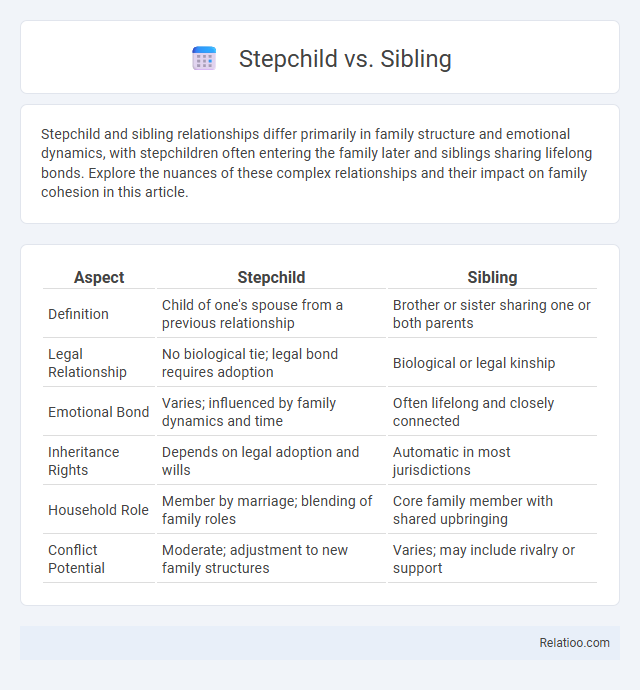Stepchild and sibling relationships differ primarily in family structure and emotional dynamics, with stepchildren often entering the family later and siblings sharing lifelong bonds. Explore the nuances of these complex relationships and their impact on family cohesion in this article.
Table of Comparison
| Aspect | Stepchild | Sibling |
|---|---|---|
| Definition | Child of one's spouse from a previous relationship | Brother or sister sharing one or both parents |
| Legal Relationship | No biological tie; legal bond requires adoption | Biological or legal kinship |
| Emotional Bond | Varies; influenced by family dynamics and time | Often lifelong and closely connected |
| Inheritance Rights | Depends on legal adoption and wills | Automatic in most jurisdictions |
| Household Role | Member by marriage; blending of family roles | Core family member with shared upbringing |
| Conflict Potential | Moderate; adjustment to new family structures | Varies; may include rivalry or support |
Understanding the Terms: Stepchild vs Sibling
Stepchild refers to the child of one's spouse from a previous relationship, while sibling denotes a brother or sister sharing at least one biological or adoptive parent. Understanding the distinction between stepchild and sibling is essential for legal, inheritance, and family dynamics, as rights and responsibilities often differ. These definitions impact custody, support obligations, and family recognition, highlighting the importance of precise terminology in family law.
Family Dynamics: Integrating Stepchildren and Siblings
Integrating stepchildren and siblings requires navigating complex family dynamics influenced by age, individual personalities, and established relationships. Successful blending often hinges on fostering open communication, setting clear boundaries, and promoting mutual respect to build trust among all family members. Consistent family routines and shared activities further strengthen bonds, helping stepchildren and siblings develop harmonious connections over time.
Legal Rights and Responsibilities
Stepchildren generally do not have automatic legal rights or responsibilities toward their stepparents unless adoption or formal guardianship occurs, while siblings hold inherent legal rights such as inheritance and familial support duties. Inheritance laws typically favor biological siblings over stepchildren unless a will explicitly includes the stepchild. Child support and custody obligations apply to biological parents and legal guardians but rarely extend to stepparents, highlighting distinct legal boundaries between these familial relationships.
Emotional Adjustments in Blended Families
Emotional adjustments in blended families often vary significantly between stepchildren and siblings, as each relationship faces unique challenges related to loyalty conflicts and identity formation. You must recognize that stepchildren may struggle with feelings of divided allegiance towards biological parents, while siblings in blended families work to establish new bonds and shared family identities. Understanding these dynamics can foster healthier communication and emotional resilience within your blended household.
Challenges Faced by Stepchildren Compared to Siblings
Stepchildren often face unique emotional challenges compared to siblings, including feelings of exclusion or divided loyalty within blended families. Your stepchild may struggle with identity and acceptance as they navigate complex family dynamics that biological siblings typically do not encounter. These difficulties can impact their sense of stability and belonging, making tailored support essential for healthy integration.
Parenting Approaches for Stepchildren and Siblings
Parenting approaches for stepchildren often require blending respect for existing sibling bonds with sensitivity to the new family dynamics, emphasizing clear communication and consistent boundaries. You should prioritize fostering trust and emotional security by validating the unique experiences of stepchildren while encouraging siblings to support one another's adjustment. Creating a balanced environment that respects both stepchildren's integration and sibling relationships helps promote harmony and mutual respect within the blended family.
Building Healthy Relationships Between Stepchildren and Siblings
Building healthy relationships between stepchildren and siblings require consistent communication and respect for individual boundaries to foster mutual understanding and trust. Establishing shared activities and emphasizing common interests can bridge gaps created by family blending, promoting positive interactions and emotional bonding. Recognizing and addressing potential conflicts early helps create an inclusive environment where stepchildren and siblings feel valued and supported.
Common Myths About Stepchildren and Siblings
Stepchildren and siblings often face misconceptions, such as the myth that stepchildren inherently have more behavioral problems than biological siblings, which research disproves by showing similar emotional adjustment levels. Another common myth asserts that siblings automatically share stronger emotional bonds than stepchildren, while studies reveal that close relationships can develop equally in blended families with positive communication. Believing stepchildren are less loyal than biological siblings ignores the complexity of family dynamics and individual personalities in blended family structures.
Long-Term Outcomes for Stepchildren Versus Siblings
Long-term outcomes for stepchildren compared to siblings often reveal differences in emotional well-being, educational attainment, and social relationships due to varying family dynamics. Research indicates that stepchildren may face more adjustment challenges, such as lower academic performance and higher behavioral issues, influenced by factors like parental involvement and stability. Your focus on these disparities can help tailor support strategies to improve resilience and foster healthier stepfamily relationships.
Tips for Fostering Harmony in Blended Families
Fostering harmony in blended families involving stepchildren and siblings requires clear communication and establishing consistent family rules to create a sense of fairness and belonging. Encouraging shared activities and respecting individual emotional needs helps build trust and positive relationships among stepchildren and siblings. Prioritizing open dialogue and empathy reduces conflicts and promotes understanding in complex family dynamics.

Infographic: Stepchild vs Sibling
 relatioo.com
relatioo.com